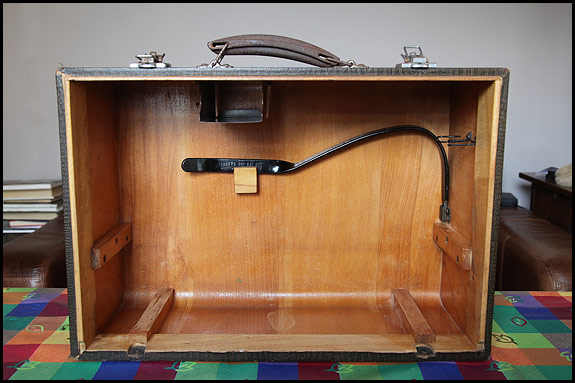Typical! We’ve had a knee-lever Singer 99K lurking in a corner of Elsie’s sewing room for ages, and today we sold it. And no sooner had I closed the front door behind the proud purchaser than I realised I hadn’t taken any pictures of it set up ready to sew or of the inner workings! So here’s a brief explanation of the knee-lever controller, minus some snaps which really would have been a big help. But I’m sure we’ll manage somehow.
OK, check out that page from the 1930 US Singer catalogue, which shows a knee-lever 99K all plugged into that cute wall light fitting and rarin’ to go. Now take a squint at this picture, which is of the 99 we sold today, sitting quietly on our kitchen table with its awesome 1960’s plastic tablecloth which stops sewing machine oil soaking into the wood …
Notice how it looks much like any other early 99K – until you spot that hole to the right of the base. That’s the magic hole into which you insert the Knee Lever, which is the black metal queerthing hanging in the back of the case …
The down-pointy end of that is the one which plugs into the hole in the front of the case, and t’other end is the go-faster bit.
OK so far? How it’s used is simplicty itself. Place the machine on your table close to the front edge of it, plug the usual old Singer plug into the socket under the balance wheel, then insert the knee-lever into that hole on the front. It only goes in one way and there’s a bit of a knack to it, but once you realise exactly how it fits, you’re laughing. You then switch the power on at the wall socket (‘cos nowadays we don’t run sewing machines off a light fitting) and prepare to do some serious sewing.
It’s at this point that you wonder why on earth the lever doesn’t hang more or less straight down, as you might expect it to. It actually hangs at about 7 o’clock, and that seems all wrong – until you realise that Singer in their wisdom wanted you to sit more to the left than you perhaps normally would, so you move your chair accordingly. Et voilà, the lever falls conveniently against your right knee (or lower thigh, depending) and off you go. A gentle right-wards pressure speeds the motor up nice and progressively, and when you return your leg to its resting position, the motor slows and stops.
How it works is simple. Inside the compartment on the right of the base, under a slightly different black steel lid to the usual one in that this one has a screw holding it shut, is the mechanism of the speed controller. It’s pretty much the same as is in the usual floor pedal. When you insert the knee-lever into the magic hole, it connects via an ingenious linkage to the actual speed controller thingy, which doesn’t care in the slightest whether its innards are moved by a lever or by a button on a box on the floor.
So now you know how it all works, you’re wondering why. As in, what’s the point? Well, for a start, if you’re not blessed with two feet which work pretty much normally, and especially if you’re in a wheelchair, the knee-lever is brilliant. You don’t have a foot pedal kicking about on the floor with a wire running from it up to the machine, and there’s only one wire coming out the plug under the balance wheel. And after that, I’m struggling …
I have no idea when Singer dropped the knee-lever variant, but it was certainly after 1951 because the 99 in that snap is a Centenary model. Nor am I sure for which models it was available, but I do know that I’ve seen a knee-lever 66, a 99 and a 201.
Elsie’s not a big fan of knee-levers, and as far as I’m concerned they’re just an interesting variation on the normal. From my point of view, though, they have two drawbacks. One is that they’re a pig to re-wire because of the way the wiring’s crowded in on the machine (and in view of their age, most of them need re-wiring). The other’s that although the actual conversion to foot pedal control is straightforward enough, you’re left with that hole in the front of the base and you need a new lid for the side compartment.
I think that’s it. If it isn’t, do leave me a comment!



You must be logged in to post a comment.